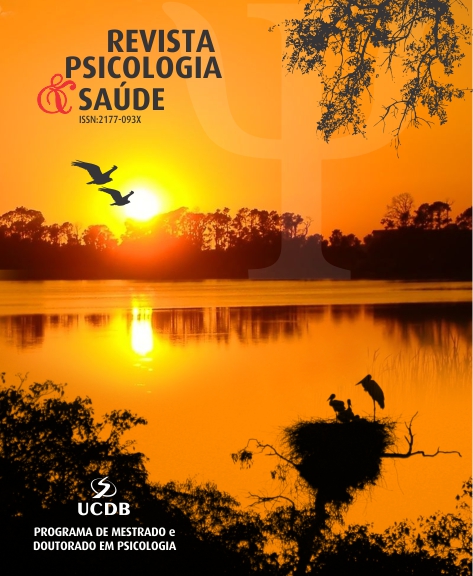Prevalence of Physical Exercise Addiction in Practitioners of Extreme Conditioning Programs
DOI:
https://doi.org/10.20435/pssa.v15i1.2398Keywords:
pain sensibility, injury risks, quality of life, Extreme Conditioning Programs, exercise addictionAbstract
In this study, we sought to determine the prevalence of exercise dependence in practitioners of extreme conditioning programs, analyzing its impact on quality of life, risk of injuries and sensitivity to pain. 368 Crossfit® practitioners and the Exercise Addiction inventory questionnaire was used to assess dependence, the WHOQOL-bref to assess dependence quality of life, and, to assess the risks of a possible musculoskeletal injury, the Sport Readiness Questionnaire with a Focus on Musculoskeletal Injuries was used. Data were analyzed using the Shapiro-Wilk test, Spearman correlation and Odds Ratio (OR) and 95% confidence interval (95% CI). All analyzes were carried out considering a significance level of 5%. The dependence prevalence was 14.40% and a correlation was found between dependence and the physical domain (r = 0.125, p = 0.017) and between the environmental domain and dependence (r = -0.142, p = 0.006). An association was also found between positive dependence and the environment domain (OR: 1.094, CI = 1.046-1.143). The prevalence of exercise dependence was 14.40%. Dependence can influence negatively on the environmental domain and positively on the physical domain.
References
Antunes, H. K. M., Andersen, M. L., Tufik, S., & De Mello, M. T. (2006). O estresse físico e a dependência de exercício físico. Revista Brasileira de Medicina do Esporte, 12, 234–238. https://doi.org/10.1590/S1517-86922006000500002
Aune, K. T., & Powers, J. M. (2017). Injuries in an Extreme Conditioning Program. Sports Health, 9(1), 52–58. https://doi.org/10.1177/1941738116674895
Claudino, J. G., Gabbett, T. J., Bourgeois, F., Souza, H. de S., Miranda, R. C., Mezêncio, B., Soncin, R., Cardoso Filho, C. A., Bottaro, M., Hernandez, A. J., Amadio, A. C., & Serrão, J. C. (2018). CrossFit Overview: Systematic Review and Meta-analysis. Sports Medicine – Open, 4(1), 11. https://doi.org/10.1186/s40798-018-0124-5
Corazza, O., Simonato, P., Demetrovics, Z., Mooney, R., van de Ven, K., Roman-Urrestarazu, A., Rácmolnár, L., De Luca, I., Cinosi, E., Santacroce, R., Marini, M., Wellsted, D., Sullivan, K., Bersani, G., & Martinotti, G. (2019). The emergence of Exercise Addiction, Body Dysmorphic Disorder, and other image-related psychopathological correlates in fitness settings: A cross sectional study. PloS One, 14(4), e0213060. https://doi.org/10.1371/journal.pone.0213060
Dalle Grave, R., Calugi, S., & Marchesini, G. (2008). Compulsive exercise to control shape or weight in eating disorders: Prevalence, associated features, and treatment outcome. Comprehensive Psychiatry, 49(4), 346–352. https://doi.org/10.1016/j.comppsych.2007.12.007
Di Lodovico, L., Poulnais, S., & Gorwood, P. (2019). Which sports are more at risk of physical exercise addiction: A systematic review. Addictive Behaviors, 93, 257–262. https://doi.org/10.1016/j.addbeh.2018.12.030
Dominski, F. H., Serafim, T. T., Siqueira, T. C., & Andrade, A. (2021). Psychological variables of CrossFit participants: A systematic review. Sport Sciences for Health, 17(1), 21–41. https://doi.org/10.1007/s11332-020-00685-9
Egorov, A. Y., & Szabo, A. (2013). The exercise paradox: An interactional model for a clearer conceptualization of exercise addiction. Journal of Behavioral Addictions, 2(4), 199–208. https://doi.org/10.1556/JBA.2.2013.4.2
Fleck, M. P., Louzada, S., Xavier, M., Chachamovich, E., Vieira, G., Santos, L., & Pinzon, V. (2000). Aplicação da versão em português do instrumento abreviado de avaliação da qualidade de vida “WHOQOL-bref”. Revista de Saúde Pública, 34, 178–183. https://doi.org/10.1590/S0034-89102000000200012
Freire, G. L. M., Fortes, L. S., Moreira, J. a. G. L. F., Alves, J. F. N., Souza, M. F. d, & Nascimento, J. R. A. (2021). Frequência semanal de treino como um fator associado a dependência ao exercício em atletas recreacionais. Cuadernos de Psicología del Deporte, 21(2), 1–12.
Grant, J. E., Potenza, M. N., Weinstein, A., & Gorelick, D. A. (2010). Introduction to Behavioral Addictions. The American journal of drug and alcohol abuse, 36(5), 233–241. https://doi.org/10.3109/00952990.2010.491884
Hausenblas, H. A., & Downs, D. S. (2002). Exercise dependence: A systematic review. Psychology of Sport and Exercise, 3(2), 89–123. https://doi.org/10.1016/S1469-0292(00)00015-7
Hopkins, W. G., Marshall, S. W., Batterham, A. M., & Hanin, J. (2009). Progressive statistics for studies in sports medicine and exercise science. Medicine and Science in Sports and Exercise, 41(1), 3–13. https://doi.org/10.1249/MSS.0b013e31818cb278
Joyce, C. R., Zutshi, D. W., Hrubes, V., & Mason, R. M. (1975). Comparison of fixed interval and visual analogue scales for rating chronic pain. European Journal of Clinical Pharmacology, 8(6), 415–420. https://doi.org/10.1007/BF00562315
Klimek, C., Ashbeck, C., Brook, A. J., & Durall, C. (2018). Are Injuries More Common With CrossFit Training Than Other Forms of Exercise? Journal of Sport Rehabilitation, 27(3), 295–299. https://doi.org/10.1123/jsr.2016-0040
Lichtenstein, M. B., & Jensen, T. T. (2016). Exercise addiction in CrossFit: Prevalence and psychometric properties of the Exercise Addiction Inventory. Addictive Behaviors Reports, 3, 33–37. https://doi.org/10.1016/j.abrep.2016.02.002
Modolo, V. B., Antunes, H. K. M., de Gimenez, P. R. B., De Mello Santiago, M. L., Tufik, S., & de Mello, M. T. (2011). Negative addiction to exercise: Are there differences between genders? Clinics, 66(2), 255–260. https://doi.org/10.1590/S1807-59322011000200013
Magalhães Neto, A. R., , L. F., & Bertoncello, D. (2022). Prontidão para o esporte: Foco nas lesões musculoesqueléticas. Saúde e Pesquisa, 15(1), Artigo 1. https://doi.org/10.17765/2176-9206.2022v15n1.e9058
Oliveira, D. V. de, Freire, G. L. M., Bortolussi, I., Oliveira, R. V., & Júnior, J. R. A. N. (2021). Autoestima e Dependência de Exercício em Praticantes de Musculação. Revista Psicologia e Saúde, 13(4), 171–182. https://doi.org/10.20435/pssa.v13i4.1201
Sicilia, Á., Bracht, V., Penha, V., Almeida, U. R., Ferriz, R., & Alcaraz-Ibáñez, M. (2017). Propiedades Psicométricas del Exercise Addiction Inventory (EAI) en una Muestra de Estudiantes Brasileños Universitarios. Universitas Psychologica, 16(2), Artigo 2. https://doi.org/10.11144/Javeriana.upsy16-2.ppea
Silveira Júnior, J. A. da, Coelho, C. de F., Hernandez, A. J., Espinosa, M. M., Calvo, A. P. C., & Ravagnani, F. C. de P. (2016). Questionário de prontidão para o esporte com foco nas lesões musculoesqueléticas. Revista Brasileira de Medicina do Esporte, 22, 361–367. https://doi.org/10.1590/1517-869220162205159806
Simón Grima, J. S., Estrada-Marcén, N., & Montero-Marín, J. (2019). Exercise addiction measure through the Exercise Addiction Inventory (EAI) and health in habitual exercisers. A systematic review and meta-analysis. Adicciones, 31(3), 233–249. https://doi.org/10.20882/adicciones.990
Szabo, A., Griffiths, M. D., de La Vega Marcos, R., Mervó, B., & Demetrovics, Z. (2015). Methodological and Conceptual Limitations in Exercise Addiction Research. The Yale Journal of Biology and Medicine, 88(3), 303–308.
Terry, A., Szabo, A., & Griffiths, M. (2004). The Exercise Addiction Inventory: A new brief screening tool. Addiction Research & Theory, 12(5), 489–499. https://doi.org/10.1080/16066350310001637363
Veale, D. (1995). Does Primary Exercise Dependence really exist? In J. Annett, B. Cripps, & H. Steinberg (Orgs.), Exercise Addiction: Motivation for participation in sport and exercise (p. 71–75). British Psychological Society.
Weinstein, A., & Szabo, A. (2023). Exercise addiction: A narrative overview of research issues. Dialogues in Clinical Neuroscience, 25(1), 1–13. https://doi.org/10.1080/19585969.2023.2164841
Zou, L., Yang, P., Herold, F., Liu, W., Szabo, A., Taylor, A., Sun, J., & Ji, L. (2022). The Contribution of BMI, Body Image Inflexibility, and Generalized Anxiety to Symptoms of Eating Disorders and Exercise Dependence in Exercisers. International Journal of Mental Health Promotion, 24(6), 811–823. https://doi.org/10.32604/ijmhp.2022.024862
Published
How to Cite
Issue
Section
License

This work is licensed under a Creative Commons Attribution 4.0 International License.
The articles published on journal Psicologia e Saúde holds the copyrights of all texts published by it. Due to that, there is a demand for a letter of copyright cession (see Appreciation). The full reproduction of any article of this Journal in other publications, by any means, requires a written authorization of the Editorial Board. Partial reproductions of articles (abstracts, more than 500 words of text, tables, pictures and other illustrations, sound files) should have the written permission of the Editorial Board and the Authors.












